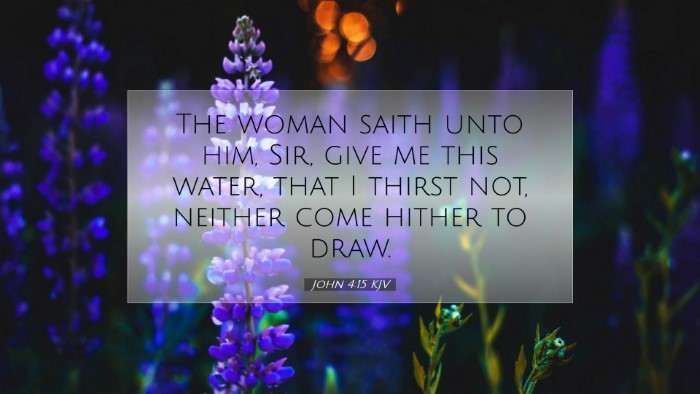Commentary on John 4:15
John 4:15 states:
"The woman said to Him, 'Sir, give me this water, that I may not thirst, nor come here to draw.'" (NKJV)
Introduction
This passage occurs in the context of Jesus’ encounter with the Samaritan woman at the well, demonstrating both His profound wisdom and divine purpose. The dialogue explores spiritual thirst, the nature of living water, and the transformative power of Christ's message.
Insights from Public Domain Commentaries
Matthew Henry's Commentary
Matthew Henry emphasizes the significance of the woman's request for water. He notes that her immediate response reflects a carnal understanding of Christ's offering. While she desires physical relief from her daily burden, she is unaware that Jesus is speaking of spiritual sustenance that quenches the soul's thirst.
- Spiritual Thirst: Henry points out that all human beings experience a deep-seated thirst for something beyond mere physical satisfaction—a longing for spiritual fulfillment.
- Christ as the Source: This request illustrates the universal need for Christ. Jesus identifies Himself as the living water, which satisfies the soul's desires and needs.
Albert Barnes' Commentary
Albert Barnes elaborates on the woman's plea, interpreting it as a natural human desire. He states, "She asks for water, yet does not perceive the spiritual implications of what Jesus offers." Barnes illustrates that, in this context, living water signifies the Holy Spirit and eternal life, bringing an everlasting satisfaction that earthly water cannot provide.
- The Gift of God: Barnes accentuates that the water Jesus speaks of is a gift from God, free and available to all who seek it. This reinforces the grace underlying Christ's mission.
- Transformation: He highlights that a true understanding of this 'living water' would lead to a transformation in the woman's life, shifting her from temporal concerns to a perennial thirst quenched through a relationship with Christ.
Adam Clarke's Commentary
Adam Clarke provides a more detailed cultural context surrounding the Samaritan woman. He interprets her fervent plea as indicative of her desperate need to escape the burdens of her life—represented by the toil of fetching water. Clarke stresses that her encounter with Jesus represents a turning point, where her mundane existence can be radically transformed into one marked by spiritual vitality.
- Symbolism of Water: Clarke elucidates that the living water symbolizes not only the life-giving presence of Christ but also the means of salvation that transcends the limitations of the physical world.
- Invitation to Receive: Clarke points out that by asking for this living water, the woman unwittingly expresses the innate human desire for redemption and grace, showcasing her readiness for a deeper spiritual encounter.
Theological Implications
The dialogue encapsulated in John 4:15 presents several important theological concepts that are relevant for pastors, students, theologians, and Bible scholars:
- The Nature of Christ's Ministry: This passage highlights Christ’s outreach to marginalized individuals—Samaritans, in this case—demonstrating that the Gospel is for all, transcending ethnic and social barriers.
- The Essence of Living Water: The living water offered by Christ is a metaphorical representation of eternal life and the Holy Spirit, suggesting that true fulfillment is found only in communion with God.
- Human Desire for God: This encounter signifies that every human heart yearns for something greater than itself, a quest only satisfied by a relationship with Jesus.
Application for Modern Believers
For contemporary followers of Christ, John 4:15 invites reflection on several practical applications:
- Awareness of Spiritual Thirst: Believers are encouraged to recognize their own spiritual thirst and seek fulfillment in Christ alone, rather than in worldly pursuits.
- Evangelistic Opportunity: The passage serves as a reminder to engage those in our community who may feel marginalized or unseen, offering them the hope of the Gospel that Christ provides.
- Living as Vessels of Grace: Just as Jesus offered living water, Christians are called to be conduits of grace, sharing the message of salvation and spiritual nourishment with others.
Conclusion
John 4:15 encapsulates a significant moment in the Gospel narrative, revealing Jesus’ divine mission and deep understanding of human needs. By providing living water, He transcends physical limitations, inviting all to partake in the spiritual sustenance that leads to eternal life. This commentary, drawing from the insights of esteemed theologians, encourages believers to understand, appreciate, and share the life-giving truth of Christ in their own lives and communities.


